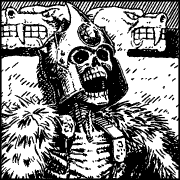|
In my second game, there is no initiative. It's a monster-hunting game where the players fight particularly large and scary beasts. The monster will have a set number of turns (3-5 usually), while the players only have one each. The players then decide what order all the turns are taken. It's been an interesting system to play around with, and really changes the risk-reward feeling of combat ("the monster only has a little HP left! Should we all stack our turns first?") I am almost certainly not the first person to think of this system, but I haven't played a game that's done it.
|
|
|
|

|
| # ? Jun 1, 2024 23:01 |
|
Nessus posted:I don't think you have to be ashamed if you got these ideas from business crap... Darwin was in large part inspired by Adam Smith, and we're posting this on a tool meant to ensure nuclear command survival when fighting the Reds. The street finds its own use for things I'm not particularly ashamed, but I'm not a huge fan of the recent trend I've been seeing of Forbes and Business Insider going "what IS this mysterious gaming trend that everybody seems to be using that corporations are training their executives with" (exaggeration). I think it's pretty neat that people are seeing the value of a collaborative narrative exercise having benefits both in personal and professional development, but I have seen corps ruin good things before when they run it into the ground, so I'm always a bit leery going back and forth with trendy business things. -- I like the idea behind initiative cards as a deck! I have been thinking about modeling some amount of predictability but also randomness. I like the appeal of this streamlined deckbuilding for complex things other than the basic "players/enemy" duality. I had some design thoughts about an unpredictable or buck wild monster like the horse fight scene from the start of John Wick 2? 3? Combining this with FATE-esque scene invokes or whatnot would be pretty neat, but it could representing a shifting battle from one area to the next in a more concrete way.
|
|
|
|
DalaranJ posted:It's fun to talk about interesting existing initiative systems, but I'd like to get at a more fundamental set of questions. Initiative exists, or ought to exist, to deal with two fundamental problems that apply to every game: a) How do you prevent the order in which a player goes providing them with an advantage or disadvantage? b) In a game with turn-taking and more than two players, how do you avoid players spending most of their game time not playing? And the third from wargames: a) How do you simulate something that does not involve turn-taking in a turn-taking game? A reasonable concern is that in practice, almost all of these have been tossed out in modern RPGs in favor of ease of play. Which is understandable, except that if initiative isn't going to achieve its goals, there's no reason to have it at all.
|
|
|
|
An interesting system in regards to "initiative" is Twilight 2000 V1. Every combatant, player or NPC, gets a maximum of 6 "actions" per turn. Every character and NPCs turn is resolved simultaneously. It was made to represent the gruesomeness of modern gunfights, where skill and experience don't guarantee survival. A random militia member can fire his gun within a split second of you, resulting in both of you being shot. What differentiates an experienced combatant and a regular person is that less experienced characters got less than 6 actions. Having a high "initiative" in that game meant getting to use all six actions, while less combat focused characters would get less. Pretty realistic, especially for long range gunfights. But very very cumbersome.
|
|
|
|
Board games have things to teach us. Two immediately come to mind as potentially usable in an RPG. In Robo Rally, players use program cards to lay out a series of five actions for their robots, but secretly; then, the players all turn over card 1, and those are resolved in an order determined by a priority (might as well be "initiative") number on the cards (all of the cards in the deck have different numbers, so there's never a simultaneous initiative);  Between the five actions, various board elements go as well (for example, a smasher might activate on turns 2 and 4). The challenge in programming your robot comes from the limitation of the cards you happen to have in your hand, the tendency of your robot to interact in unpredictable ways with the other players' robots (you ordered a move, but another bot just ran into you and pushed you one square, and now the move you ordered will put you into a hazard you were trying to avoid). Worse, as your robot takes damage, your hand shrinks; and if you get to the point where your new hand is fewer than 5 cards, then you have to leave actions (the final actions of your turn) "locked" from one round to the next, until you get a chance to heal up. In the Monolith (Asmodee) Conan board game, the player playing the enemies has a tray setup, with a row of slots in it.  The less powerful enemies on the table are grouped, with each group having a cardboard tile that sits in a slot; powerful characters and monsters have their own tile. The cost of activating a tile is lower the further it sits to the left; after the monster or group of enemies activates, its tile moves to the rightmost slot, and all the others move up one. So, there's a choice of spending more resource in order to reactivate a group or monster that has moved recently. Since all the tiles are face up, the players can see that some are cheap to activate next and some expensive, and can thus make strategy around that: either force the bad guys to make an expensive activation to stop them from what they're doing, or, attack a group that is likely to move soon to reduce its size and power, etc. There are also additional things that can be done with this system; there's a tile used in most scenarios called an "event tile" that allows the controller to do something thematic, like bring on reinforcements or change the situation in some way. In the game, players and the overlord alternate (the players all go, in whatever order they want, then the overlord goes), and the overlord gets to activate 0, 1, or 2 tiles before passing back to the players.
|
|
|
|
 Roleplaying rock solution for roll20...
|
|
|
|
We had this come up in our Shadowrun game today! The GM thought everyone sitting around being very quiet meant they weren't engaged in the investigation he'd made which he thought was super cool and felt bad that he had completely misjudged it. Turns out 3 of players were each doing a thing where they thought one of the other quiet ones hadn't done anything yet and so were waiting for them to speak up and do something before they themselves did a second thing. So, we're gonna do rock passing for investigation time, except it's first "does anyone have any ideas or anything they want to do?" so if someone's inspired they can do a thing and everyone can go hell yeah, if not or if everyone that has said a thing has gone we go clockwise round the table (well, left to right in the roll20 portraits, but, y'know) so we don't end up with a stand-off of people being too polite to engage. It's a not problem normally, but the game has 6+GM instead of the usual 4+GM and both the new players vacillate between being very quiet and taking the lead so everyone is a little more mindful of sharing the spotlight for when they're quiet.
|
|
|
|
Zeerust posted:I think 4 is kind of a misleading question, because from what I've seen and played of PbtA games, an informal initiative system is almost always instituted to maintain an equal spotlight between players. A formal initiative system doesn't exist for two reasons: Under the hood, this is one MC move (announce future badness) being used to set up the more hard/direct move (inflict harm as established). If you are only ever responding to your players' rolls, you're hamstringing the narrative impact of your NPCs.
|
|
|
|
Xarbala posted:Lancer uses alternating turns between players and the gm, with players choosing amongst themselves to see who goes first. Last player to go nominates the next among whichever players haven't gone this round and they alternate with the gm until one side is done and the remaining units get to move too (usually just a gaggle of NPCs). I've not read Lancer, but this is how my dungeon crawl project works within a given combat phase or non-combat turn.
|
|
|
|
I'll be honest, it never really occurred to me to question why AW doesn't have an initiative system like dnd because in AW, combat is just narrative by other means. Flipping it around is more telling: why does dnd (and wod) have fiddly initiative for combat, but not for conversations or cave diving or what have you.
|
|
|
|
EthanSteele posted:We had this come up in our Shadowrun game today! The GM thought everyone sitting around being very quiet meant they weren't engaged in the investigation he'd made which he thought was super cool and felt bad that he had completely misjudged it. Turns out 3 of players were each doing a thing where they thought one of the other quiet ones hadn't done anything yet and so were waiting for them to speak up and do something before they themselves did a second thing. For investigation stuff its really on the GM to go around to the players who haven't done something yet and go "is there something you want to check out" and/or offer some suggestions on courses of action. Either reminding them of stuff they know a little about but haven't checked out further, or things that would make sense for their character to think about investigating further, or just general obvious meat the other players have left on the bones of the investigation. Starting from someone who has something they want to do and cycling between players who tend to be quiet and players who tend to be more proactive can be useful so it isn't always the quiet people picking up the scraps is often a good strategy too. Can always grab a piece of paper or open a notepad file, put everyones name, and jot down a tickmark or quick note about their action and make sure everyone has some screen time. aldantefax posted:I like the idea behind initiative cards as a deck! I have been thinking about modeling some amount of predictability but also randomness. I like the appeal of this streamlined deckbuilding for complex things other than the basic "players/enemy" duality. I had some design thoughts about an unpredictable or buck wild monster like the horse fight scene from the start of John Wick 2? 3? Combining this with FATE-esque scene invokes or whatnot would be pretty neat, but it could representing a shifting battle from one area to the next in a more concrete way. I know there have been some systems that have functioned with decks for things like initiative, and it tends to work as well as any other system. Though you do get some meta play around the knowledge of whats left in the deck and whats been drawn, which can be good or bad depending on the goal/feel of the game. hyphz posted:A reasonable concern is that in practice, almost all of these have been tossed out in modern RPGs in favor of ease of play. Which is understandable, except that if initiative isn't going to achieve its goals, there's no reason to have it at all. I don't think that they've been thrown out in favor of ease of play. I think instead you have to look at what initiative actually achieves. Overall the one thing every system aims for is that everyone gets a turn, many systems have some randomness so that turns aren't always the same order (or combat to combat they aren't the same order), and many have some balance issues in mind (because going first is very good especially if your game trends towards rocket tag). Something like PbtA goes "initiative creates a problem where the world feels frozen while each character's turn happens", along with "with some guidance the gm can be sure to spread the spotlight around". Making sure that everyone gets the exact same number of turns isn't a concern as long as you make sure someone isn't hogging or getting left out, and rocket tag isn't a thing they need to solve. It still has initiative in a sense, it just is more like if you had the DM roll initiative for the players, record it behind the screen, and tell the players when their turn came up each turn.
|
|
|
|
Initiative for the dungeoneering part of d&d makes me think of the campfire actions for Darkest Dungeon. Alternatively, there are the travel roles in The One Ring. On the other hand, the travel roles sort of exist in modern D&D, only you just say "I have the best bonus in the skill, so I'm the Knowledge Guy, you're the Talking Guy, and you're the Search guy." There isn't much else to discuss when it comes to dungeoneering.
|
|
|
|
e: nm
Absurd Alhazred fucked around with this message at 18:55 on Jul 22, 2020 |
|
|
|
ZypherIM posted:For investigation stuff its really on the GM to go around to the players who haven't done something yet and go "is there something you want to check out" and/or offer some suggestions on courses of action. Either reminding them of stuff they know a little about but haven't checked out further, or things that would make sense for their character to think about investigating further, or just general obvious meat the other players have left on the bones of the investigation. This is good, but it does raise a question: when the point of the game is investigating and heisting and the enjoyment is supposed to be from figuring it out and putting it all together, how do we best enable players that aren't very good at it/think they're not very good at it to engage without taking away the enjoyment of figuring it out and putting it all together. It sometimes feels like there is a fine line between a prod in a direction and just telling them what to do/playing the character for them.
|
|
|
|
ZypherIM posted:I don't think that they've been thrown out in favor of ease of play. I think instead you have to look at what initiative actually achieves. Overall the one thing every system aims for is that everyone gets a turn, many systems have some randomness so that turns aren't always the same order (or combat to combat they aren't the same order), and many have some balance issues in mind (because going first is very good especially if your game trends towards rocket tag). What I was referring to there was the older game systems of simoultaneous resolution, segment-based initiative, team-based initiative etc. The RPG standard of "you roll initiative and use it for turn order" is drastically oversimplified compared to most original initiative systems and doesn't really achieve the original goal any more.
|
|
|
|
Absurd Alhazred posted:Dungeoneering can have a lot to it, I think. You can assume everyone's together in some kind of logical marching order, or you could go initiative order if people want to be crunchier, usually because they're working independently or the dungeon is either small or full of frequent tactical combat encounters. I recently wrapped up a dungeon encounter in a small, elaborate dungeon where we spent three sessions in an extended combat/exploration/running the gently caress away before the whole thing collapsed, I had a good time and I think the players did, too. I'm gonna chime in and remind people that Goblinville is an excellent, modern take on dungeoneering complete with marching order and resource tracking.
|
|
|
|
DalaranJ posted:It's fun to talk about interesting existing initiative systems, but I'd like to get at a more fundamental set of questions. Time to fire up the ramble engine... I believe that initiative exists from the era of wargames scaling up to have more than just two players where it would be tactically relevant to know who goes in what order in matters of life and death. Initiative does exist but as a more generalized concept in other activities, just not explicitly called out as such. Keeping in mind that one of the things that D&D does is try to ensure that everybody is accounted for in the complex business of combat (Alhazred's point). Having a discrete initiative order means that everybody gets some kind of clear-cut agency in the most 'intense' part of the game (some would argue, anyway). I think newer DMs may not be used to actively corralling players and giving them all a semi-fair shake to do something like what PbtA games, AW, etc. uses - the more "improv-forward" way of those systems completely eschewing a more structured method in the hope it will balance out may, in theory, not apply as well when operating at a brand new table. So, "Why does initiative exist?" It's a helper tool by original design to 'guarantee' engagement, perhaps. I think when you consider this in mind and that initiative is another structure for taking turns, then it is used or not used deliberately in systems in order to conceptually make sure everybody gets some amount of screen time when things get the most chaotic. I think one could argue that initiative represents the narrative camera swinging in a very deliberate way from one character to the next, and part of the next evolution of RPGs is to remove this 'guard rail' as it is assumed that the person running the game can identify opportunities to let players shine. One of the older things that D&D used to put forward is specifically not to be a fan of the players, or to go easy on them -- to instead act in a fair and impartial way and dictate what happens to them as the rules and game world dictate (hence the old terms 'judge' and 'referee'). I think that initiative is a system which also ensures a certain level of specific fairness while adding the semi-unpredictability of combat. Contrast the above from D&D (in specific) and others with one of PbtA's dogma: be a fan of the characters. It is envisioned as positioning the shared camera to get the "best shot" of every character doing the coolest and most awesome things at any given point in time, and to tastefully make a cut to another character to resolve what's going on with them. As long as everybody is having fun, it doesn't matter how much in the action economy a person gets to go, so long as you're accomplishing your core goals as a table. Initiative in D&D is also used but not explicitly when it comes to the concept of turns, which last far longer than a single combat encounter usually. This had a tendency to put things at specific time scales and different ways of handling initiative: combat-scale (the six-second round), dungeon-scale (the ten-minute turn), recovery scale (the eight hours or more of rest), and then the strategic scale (months or years as modeled by domain turns and realm-scale actions in Birthright, Lordship in BECMI, etc). There is some kind of usage and worth to determine and order things in the game world when pulling back the time scale in these days, though it is different from one table and system to another. As a result of the above, as some of these other time scales fell away from popular use (lordship and such was footnoted or removed from the core rules of D&D, as was dungeoneering related tasks to be more abstracted, etc.) the end result is that initiative had far less importance to anything other than combat, and as people found they weren't having as much fun (or more specifically, designers and their confidants in playtesters found it wasn't as much fun) the move to simplify became paramount to get out of the way of the acknowledged more fun parts of the game. Matt Colville argued pretty persuasively for the concept of strict time tracking inside of the game world (following a Gygaxian statement on the matter) but hand waved the portion regarding the smaller scales of time, mostly because those things were self-evident. However, with the above concepts in mind, initiative is there in order to make the time tracking at these smaller scales self-evident. Lack of strict time tracking from the direct rules or from a talking beard can cause a game to become more disorderly unless someone has a system to replace it. This would make sense for why other games take after D&D for its initiative system but have a different spin on it, extending beyond just the tabletop RPG or boardgame space.
|
|
|
|
EthanSteele posted:This is good, but it does raise a question: when the point of the game is investigating and heisting and the enjoyment is supposed to be from figuring it out and putting it all together, how do we best enable players that aren't very good at it/think they're not very good at it to engage without taking away the enjoyment of figuring it out and putting it all together. It sometimes feels like there is a fine line between a prod in a direction and just telling them what to do/playing the character for them. There is a fine line, but you can never really identify where that line is and it varies with each person (and probably session to session for each person). If you can, toss out some ideas that vary in tone for how they'd play out. So even if the goal is "to be sneaky" the choice of "sneaky by break-in" or "sneaky by social engineering" is vastly different and helps remove the feel of you "playing" their character. In general you should refer yourself to the GUMSHOE system and how it handles mysteries. The essential clues are never hidden, the characters can do stuff to flesh those out (or maybe find a clue with less danger or faster or more sneakily), but figuring out how they fit together is up to the players. For example, in a heist they might want a floor plan. Suggesting avenues of "break into the county clerk office", "casing the joint in person as a 'VIP'", or "contacting criminal/political 'friends' who owe you a favor" are all valid options. It still leaves the door open to their own ideas (maybe jogged by your examples), and each has a different feel and will require the players to enact something to carry out that part of their plan while carrying different risks. I think in general the approach is to give them some "elevator pitch" options which leaves specifics up to the player, but gives them a skeleton to build on. Also it can be helpful to create rough time units, so the players that tend to be more active and sort of hoover up all the stuff to investigate are unable to do so. Sometimes they'll spit out several things they want to do, make them pick one and say "while Claire is searching the library, what is Phil doing?" Something that is also important is that failed rolls don't preclude them from finding the important info. Instead have it take longer (looks like he saved every receipt for the last 5 years, this is going to take a while), or have an obstacle that they need to overcome later (everything backs up to this remote drive that you can grab now, but you'll need to break the encryption later to use it), or things like that. This helps with the thing of "oh my skill at X sucks so I'm not going to try" that sometimes develops.
|
|
|
|
Tulip posted:I'll be honest, it never really occurred to me to question why AW doesn't have an initiative system like dnd because in AW, combat is just narrative by other means. Flipping it around is more telling: why does dnd (and wod) have fiddly initiative for combat, but not for conversations or cave diving or what have you. D&D takes a kind of "adversarial" approach to combat, to make it feel more "dangerous". Your opponents are presumed to have agency over their own actions, rolling like players with successes on both sides impacting one or more targeted character's "hitpoint" clock. There's also no immediate consequences to failure on a move, so there's nothing* to lose from trying a move (*some playbooks have a resource management minigame attached). Putting this together means that the amount of consequences you suffer is strongly dependent on how many moves your side makes compared to the other side, so to keep things somewhat sensible you need to make sure each side has a "fair" number of moves. D&D goes with a kind of simulationy system of giving each agent one move each "round", which has obvious advantages and pitfalls. By comparison other common challenges are handled in a more traditional *world style. Either the GM makes a move and the users choose a defence to respond, or the players make a move and the GM adjudicates based on a semi-hidden "Difficulty level", so there's no need for "turns" and "rounds" so no need for initiative. It's a bit schizophrenic but it avoids having to bust out the initiative tracker every time you try to steal a grape. Splicer fucked around with this message at 11:04 on May 18, 2020 |
|
|
|
I want to take an aside to talk about alignments, how 5e D&D deals with them, and how other game systems deal with them. I happen to think shoeboxing people into a 9-square hole of law/chaos and good/evil is kind of a raw deal, and slapping entire races into those categories is also a bit hosed in the head but makes for some interesting schlocky fiction (see: Drizzt). I was thinking that because these are supposed to represent dramatic or ideological poles (depending on who you ask) then you could come up with alternate methods. I think the concept of having a moral/ethical alignment is useful but somewhat misunderstood. Remember the Paladin who always did "Detect Evil"? Or people making up their minds that "because a thing is Chaotic Evil, it is irredeemably bad"? These kinds of moral absolutes are good when you want to clearly state that there is someone or something that is nothing more than a hostile actor, sure, but extending that concept to entire races seems a bit too...I'm not a fan of it these days. In one of the Dimension 20 "Adventuring Academy" episodes, Brennan Lee Mulligan talks about how this situation was changed around to be of a cultural thing instead of a moral abolutist thing. Attitudes towards one another, crime and punishment were different in different cultures, thus someone who was a coward and runs away from battle could be considered "evil" in the eyes of one culture, whereas another culture views it as "good" or at least virtuous. This seems like it's way more interesting than the tic-tac-toe grid that D&D implied from AD&D through 4e. Thinking about why 5e does things well is because it acknowledges there's significantly more nuance to a character's personality and moral compass and as such they have Ideals, Bonds, and Flaws. That is a lot more informative about a character's concept, and I wish they made more than 10 per background/class lens/etc. for the base rules. I would have happily bought a web supplement or print book that was just expanded character build options along that line (I did appreciate that Xanathar's specifically made Lifepaths a part of the game with the "This is your life" systems). Why is it that people feel the need to completely eschew an alignment system? I think it might be the same reasons that they throw out stat rolling or experience points as the 'sacred cows' of other games. My first game without any alignment in it was Shadowrun, but even then it assumed that players were aligned against the corporations and had something like a rogue's heart of gold to get its version of experience points (in the SR3 companion, it did offer a completely amoral campaign option to circumvent karma). Tying mechanical resource gain to the narrative concept of "do good things to be rewarded cosmically, i guess" was an interesting concept, but almost too broad to be remembered during play. I know that older versions of D&D didn't have the good/evil axis, which is what really kind of threw the whole thing for a loop. Law and Chaos is pretty interesting, but I feel like it may be a bit broad unless you're really trying to adhere to the source inspiration (Elric Saga) to be less immediately useful to players, especially newer players. I propose that somewhere in the milieu of alignment discussions players and DMs get the opportunity to set their own dramatic poles and tie that to their fiction, since there are more than just the most broadly defined ones. Maybe they are single or multi-axis affairs, where their interactions have the most interest and apply to the majority of people in the setting where it makes sense. Some examples: - Authoritarian vs. anarchist - Individualism vs. collectivism - Austerity vs. hedonism As long as these poles can help support an interesting story and some new dynamic situations, they might define a character, society, and even race more elegantly than simply law/chaos and good/evil. I could see a society which valued putting the needs of the many over the few but characters find friction in it because they find fault in the system or experienced the pain of a personal sacrifice as a result; or a character who wants to break free of material possessions as part of the path to enlightenment, versus someone who believes excesses are the path to their own paradise. The concepts can be flexible in the narrative framework and have more interesting implications.
|
|
|
|
aldantefax posted:
It makes for much more interesting and nuanced PCs and NPCs alike.
|
|
|
|
wotc is finally printing splatbooks based on magic: the gathering settings but not once have they approached a subsystem of replacing your two alignments with a color pair, and that frankly says everything you need to know about the whole endeavor realtalk, certain ideals/worldviews being built into the fabric of reality isn't a super bad premise but like--the 9 box is such a bad implementation of that
|
|
|
|
When I was GM'ing D&D I conceptualised alignment as Good <-> Evil = Altruism <-> Sociopathy Lawful <-> Chaotic = Values existing power structures <-> seeks to undermine existing power structures Which I found a) more practical in writing and playing NPCs than vague concepts of "Good" or "Chaos" b) less judgemental than throwing the word 'evil' around and c) gave implicit permission for the players to engage with the bad guys in more interesting ways (rather than just 'is evil = kill it'). Sociopathy maybe isn't the right word to use as I'm not a medical professional at all and I'd probably be more considered using clinical words like that now, but it worked for my players at the time. These days I just play systems without alignment or strict morality impositions on the players and they are not missed. Honestly I don't really see what benefit they bring to the game by defining them in the mechanics. If as a player you want to go around saying you are a force for good and these guys are evil incarnate and must be destroyed then go ahead that can be a really cool character, especially if they aren't very self aware, but I don't think the game needs to weigh in on it by forcing to write something on your sheet from a list of (necessarily) limited options.
|
|
|
|
My take on D&D alignment is that most mortals are Unaligned, including ones bad things. Alignments with a capital A are for gods and other Cosmic things, even clerics and paladins would rarely have an actual alignment; the gods don't care what you actually believe or want as long as you serve them (to a certain level anyway) Angrymog fucked around with this message at 07:16 on May 19, 2020 |
|
|
|
tanglewood1420 posted:When I was GM'ing D&D I conceptualised alignment as tanglewood1420 posted:These days I just play systems without alignment or strict morality impositions on the players and they are not missed. Honestly I don't really see what benefit they bring to the game by defining them in the mechanics. If as a player you want to go around saying you are a force for good and these guys are evil incarnate and must be destroyed then go ahead that can be a really cool character, especially if they aren't very self aware, but I don't think the game needs to weigh in on it by forcing to write something on your sheet from a list of (necessarily) limited options.
|
|
|
|
tanglewood1420 posted:When I was GM'ing D&D I conceptualised alignment as
|
|
|
|
Splicer posted:Altruism <-> Selfishness works better for the first one, but I'm just nitpicking. Your lawful <-> chaotic however seems to imply chaotic characters will seek to undermine power structures on principle. If that's what you're going for, that these are extremes with 90% of people falling under true neutral, then Lawful should be "seeks to support existing power structures". Changing Sociopathy to Selfishness and Values to Supports are both improvements, or at least closer to what I was going for. And yeah it means in 'reality' 90% of people would be true neutral (or a split between Lawful Neutral and True Neutral perhaps), but then a D&D adventuring party are exceptional individuals and almost every NPC they deal with is also an exceptional individual in some way so I don't really think that matters much. Tiggum posted:There are some advantages to having player alignment in the rules. For example, less creative players can use it as a guide for how to roleplay their character (eg. "I'm Neutral Good so I should be doing my best to help people according to their needs") and by specifying the alignments that players are allowed to choose a GM can go some way to making sure the entire group is on the same page (eg. if everyone has to be good aligned then you're not going to save the villagers from the raiding bandits only to turn around and demand protection money from them yourselves). The D&D alignments are not necessarily the best for that (particularly when chaotic neutral - ie. I do what I want and don't have to be consistent or justify it in any way - exists) but that's more an issue with the implementation than the concept. I take your point that it can help guide new players, however in my experience D&D has developed so much cultural baggage at this point that I have never met a newbie who is interested in playing that doesn't have a strong idea of what kind of character they want to play. They may not know what class, they very likely aren't clear on what feats/abilities/spells whathave you, they definitely don't yet know whether they will enjoy playing that character in actual play. But they always have a character concept which includes an idea of their morality or alignment - the scheming rogue who's in it for gold and drat everyone else, the chivalrous warrior saving villagers from monsters, the noble druid protecting nature from the evils of the night... and so on. I don't think having a specific set of six words helps any more than just leaving a blank space where a player can write whatever they want.
|
|
|
|
My take is that D&D alignment is a bad idea executed poorly. It fails at describing characters' internal motivations, since only cartoon villains think of themselves as evil and the lawful/chaotic distinction makes it sound like that particular facet of a character's beliefs is somehow more important than the others. On a more conceptual side, defining alignments boxes in character morality in a way that's at best clumsy and at worst rife with unfortunate implications.
|
|
|
|
tanglewood1420 posted:in my experience D&D has developed so much cultural baggage at this point that I have never met a newbie who is interested in playing that doesn't have a strong idea of what kind of character they want to play. They may not know what class, they very likely aren't clear on what feats/abilities/spells whathave you, they definitely don't yet know whether they will enjoy playing that character in actual play. But they always have a character concept which includes an idea of their morality or alignment - the scheming rogue who's in it for gold and drat everyone else, the chivalrous warrior saving villagers from monsters, the noble druid protecting nature from the evils of the night... and so on. LupusAter posted:It fails at describing characters' internal motivations, since only cartoon villains think of themselves as evil
|
|
|
|
D&D alignment is primitive keywording for spell effects combined with broad-strokes role-playing in an adversarial dungeon-crawling game. It's the fault of neither D&D nor alignment that they were thrust into the spotlight and asked to model complex realities, and not surprising that they are abysmal for that.
|
|
|
|
I like how Robin Hood is basically the archetypal "chaotic good" hero, but if you follow the actually descriptions he's NG at best, and quite possibly LG. It's almost as if trying to pigeonhole someone as lawful or not without reference to what those laws actually are ends up being utterly incoherent.
|
|
|
|
homullus posted:D&D alignment is primitive keywording for spell effects This is pretty much the idea I was working from when I did my big planescape games. But in-universe. So: People are mostly just people (except when they're not). Weird planar poo poo is weird planar poo poo and there's no point really trying to understand the why and how of it, but people want to categorise weird poo poo until it makes some degree of sense to them even if the sense it makes isn't really true. So a long time ago, some poor clueless berk tried to fit all the weird planar poo poo into a grid, or maybe a circle, or a 3d spinning map globe system thing that has nuanced fading together of et ceteras, and he built brass orrreries and all that stuff to explain it. Spent years and years on it and it looked like he was gonna make it all work. Anyway, long story short, he was fundamentally wrong about a lot of really important stuff, and he was, uh, never heard from again. But he'd come close enough that his model was useful for describing how magic gets hosed up when you move between weird planar locations and for broadly describing how groups of weird planar beings relate to regular people and to each other. Sort of. The problem is that when he built this model, he used words that also have people-based meanings, like "good" and "evil", either because he was going for some meaning that's lost to history, because he was a bigoted old dickhead, or whatever else. Which is mostly fine, because most planars understand what's going on - it's hard not to when you interact with these beings directly. Primes (who lack the context) gently caress it up a fair bit, which is why there are so many of them in the dead book. Elector_Nerdlingen fucked around with this message at 13:36 on May 19, 2020 |
|
|
|
e: nm
Absurd Alhazred fucked around with this message at 18:55 on Jul 22, 2020 |
|
|
|
it sure seems like you could make an interesting system on top of the idea that cosmic forces of law, neutrality, chaos, etc, influence heroes on a personal level. shame no one has. i think dungeon world at least made an attempt. brink back alignment languages imo
|
|
|
|
Splicer posted:Please enjoy this post from a world where D&D is the new hotness trying to compete with the entrenched dogma of *world and FitD Yeah, this is the kind of interesting insight, and it's obviously not just initiative but many, many parts of the system that reinforce "combat is a high-stakes competition, non-combat is a low stakes exploration." I just dislike it  Absurd Alhazred posted:Let's say we have a character who is a rebel minor noble trying to overthrow the current king to establish her house as the royal line. Throughout a campaign she is chaotic, right? She's undermining an established order. All law-enforcement will try to put her and hers down. Then suddenly she wins. She throws the old king into an oubliette and is proclaimed the new queen. Suddenly she's lawful, all law enforcement is working for her, she's for maintaining the established order. She hasn't changed, her goals haven't changed, in what way does it make sense to say that her alignment changed? Rituals of Rebellion is a really good book, though it would amount to "she's actually lawful the whole way through because rebelling in favor of changing who slots into the same parts of a preserved power structure isn't revolution at all" Doc Hawkins posted:it sure seems like you could make an interesting system on top of the idea that cosmic forces of law, neutrality, chaos, etc, influence heroes on a personal level. shame no one has. i think dungeon world at least made an attempt. *stares in Glorantha*
|
|
|
|
e: nm
Absurd Alhazred fucked around with this message at 18:55 on Jul 22, 2020 |
|
|
|
Is this the author? https://en.wikipedia.org/wiki/Max_Gluckman https://books.google.ca/books/about/Rituals_of_Rebellion_in_South_east_Afric.html?id=2MTnAAAAIAAJ&redir_esc=y
|
|
|
|
e: nm
Absurd Alhazred fucked around with this message at 19:41 on Jul 22, 2020 |
|
|
Doc Hawkins posted:it sure seems like you could make an interesting system on top of the idea that cosmic forces of law, neutrality, chaos, etc, influence heroes on a personal level. shame no one has. i think dungeon world at least made an attempt. If the safety of my fellows depended on my inclusion of alignment into things, I would make it so that ordinary people have at most a slight inclination (which is what you put on your character sheet) and having a formal capital-letter Alignment puts you in a serious holy-man situation and probably comes with significant behavior constraints... it might indeed be a "you lose your character if this is permanent" kind of thing, because it means you've become formally and fully aligned with a cosmic principle. Only people in that situation would be affected by things like detect evil though, although people with a mild inclination towards chaotic evil might feel mild daunting in the face of a circle of protection vs evil 10' radius.
|
|
|
|
|

|
| # ? Jun 1, 2024 23:01 |
|
As someone who has gotten quite a few people who are aware of RPGs (read: they watch streams or listen to podcasts of D&D) into playing non-D&D games, almost all of those have come to the first session excitedly talking about where their character will exist on the alignment grid before being a bit deflated when one doesn't exist. My most generous reading on alignments is that they're a roleplaying aid for new players in a system which has painfully few of those - something that gets you thinking about your character's actions and beliefs. It doesn't really matter if your definition of "lawful" means "follows the letter of the law even in situations where that would result in immoral acts" and mine means "follows a personal code" because the only real benefit of alignment is that it got us thinking about whether our character believes those things. And in some cases it gives new or shy players something on their sheet to look at and point to when trying to figure out how their character might respond to a situation. Now don't get me wrong, I don't actually think that's the intention of alignments and other systems have much better tools for that purpose, but at least it's something I guess.
|
|
|













































